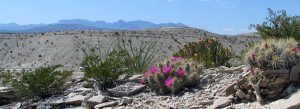
A view of the Chihuahuan Desert, situated in parts of western Texas and Mexico. Three biosphere reserves are located in this desert.
The United Nations Educational, Scientific and Cultural Organization (UNESCO), famously known for their World Heritage Sites, also has an extensive biosphere reserves program, established under the umbrella of their Ecological Sciences for Sustainable Development department. These biosphere reserves are internationally recognized conservation zones found all over the world, incorporating marine, coastal, and terrestrial ecosystems. In addition to functioning as conservation zones that preserve biodiversity, these biosphere reserves also serve as areas for scientific study, particularly in the fields of sustainability, ecology, and human development. To ensure that these biosphere reserves are properly functioning and effectively managed, UNESCO conducts a periodic review process every ten years to ensure that each reserve measures up to the international standards.

Biosphere reserve in Cuba.
This website provides an overview of biosphere reserves and their mission and lists each of the 669 biosphere reserves around the world, first by region and then by country. Here is the list for Europe and North America, and here is the list specifically for the United States. UNESCO’s biosphere reserves website relates to our class discussion of the biosphere and the importance of biodiversity in maintaining healthy ecosystems. As climate change intensifies, we see a greater need for the creation and maintenance of conservation zones like UNESCO’s biosphere reserves. However, this website also reveals that this needed maintenance is in fact not occurring. Unfortunately, in 2017, twenty biosphere reserves were withdrawn from the global list, seventeen of which were in the United States alone, and all of which were withdrawn because of their poor performance in UNESCO’s periodic review. This raises important questions about our national and global priorities for the future of such important biosphere reserves. Will we make preserving biodiversity through biosphere reserves and other forms of conservation a priority? Or will we continue to let vital ecosystems in our biosphere flounder and disappear?
